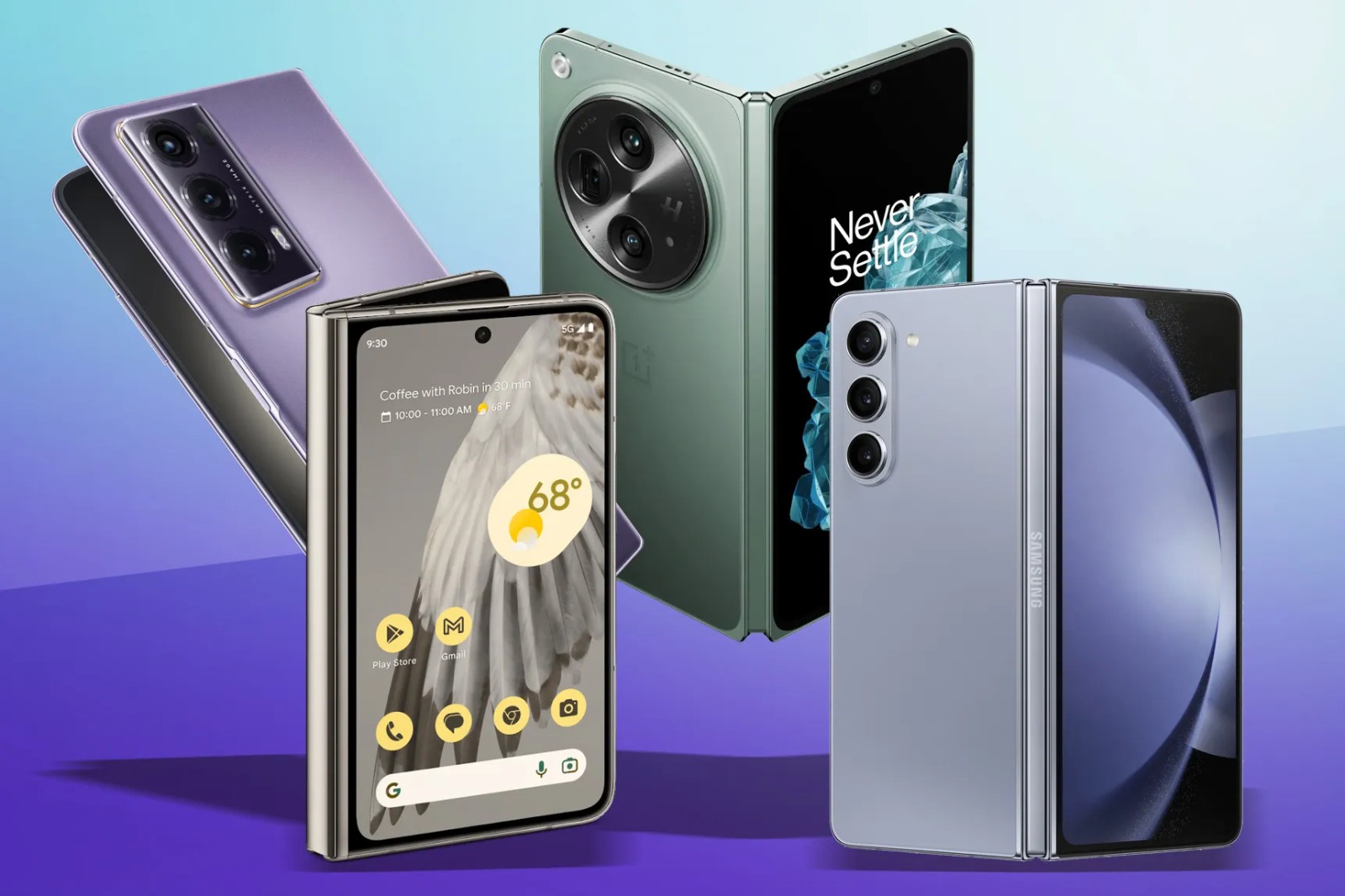
Foldable Screens in 2025: Are They Finally Worth It?
Foldable screens have finally matured, combining sleek design, durability, and high-performance hardware with multitasking and productivity features. In 2025, these devices promise to transform how we work, play, and interact with technology, bridging the gap between smartphones and tablets. But are they truly practical and worth the investment for everyday users?
✨ Raghav Jain

The Evolution of Foldable Screens: From Novelty to Necessity
When the first foldable smartphones hit the market in 2019, they were nothing short of revolutionary — but also experimental. Early models like the Samsung Galaxy Fold and Huawei Mate X were plagued by durability issues, screen creases, and price tags that made consumers skeptical. They represented innovation in its infancy: impressive in theory but impractical for everyday use.
Fast forward to 2025, and the landscape looks vastly different. Foldable screens are no longer a futuristic gimmick; they’re becoming a mainstream reality. Almost every major tech company — from Samsung, Google, and Oppo to newcomers like Tecno and Honor — has refined the formula. The result? Sleeker, more durable, and more affordable devices that finally justify their existence.
The transformation was driven by several key innovations:
- Ultra-Thin Glass (UTG) replacing fragile plastic.
- Improved hinge mechanisms rated for over 400,000 folds.
- Better crease minimization using teardrop hinge designs.
- Software optimization to make multitasking seamless.
- Foldable laptops and tablets, expanding the category beyond phones.
The shift wasn’t just technological — it was philosophical. Foldables stopped trying to prove themselves as "cool gadgets" and started solving real user problems, such as productivity, portability, and multitasking.
Technology Behind Foldables: How They Work
At the core of every foldable device is the flexible OLED display, a marvel of modern engineering. OLED (Organic Light-Emitting Diode) technology allows each pixel to emit its own light, making it thin and pliable enough to bend without cracking. The screen layers include:
- Flexible substrate – usually made from polyimide, allowing the panel to flex.
- OLED layer – producing vivid colors and deep blacks.
- Ultra-thin glass – providing rigidity and protection.
- Protective coating – shielding from scratches and fingerprints.
The hinge mechanism is equally critical. It must endure thousands of folds without loosening, collecting dust, or damaging the screen. Modern designs, like Samsung’s Flex Hinge and Motorola’s UltraDrop, allow for gapless folding and a nearly invisible crease.
Software plays a crucial role too. Android 14 and beyond have built-in foldable support APIs, letting apps adapt automatically to various screen orientations and split-screen modes. Productivity tools like Microsoft Office, Google Workspace, and creative apps like Adobe Lightroom now use the larger canvas effectively.
2025: The Year Foldables Grow Up
By 2025, foldable screens are no longer fragile novelties. They have matured into powerful, reliable devices that blend portability with performance. Several trends have shaped this transformation:
1. Durability Revolution
Manufacturers have tackled the Achilles' heel of foldables — fragility. Devices like the Galaxy Z Fold6, OnePlus Open2, and Google Pixel Fold 2 boast IPX8 water resistance, scratch-resistant coatings, and hinges tested for over 500,000 folds. Drop tests show that many modern foldables can now survive the same stress levels as flat smartphones.
2. Affordable Options
Initially priced upwards of $2,000, foldables were a luxury few could justify. But in 2025, brands like Tecno Phantom V Fold 2 and Honor Magic V3 Lite offer foldables under $900, democratizing access to cutting-edge technology. The economies of scale and competition have made them more budget-friendly than ever.
3. Enhanced Battery and Performance
Foldables once struggled with smaller batteries due to their compact form factors. Now, stacked battery technology and energy-efficient chipsets like the Snapdragon 8 Gen 4 or Tensor G4 provide all-day performance. Many foldables also support 65W or higher fast charging, something that rivals even traditional flagships.
4. The Rise of Foldable Laptops and Tablets
It’s not just phones anymore. The Lenovo ThinkPad X1 Fold 2025, Asus Zenbook Fold 17 OLED, and HP Spectre Foldable have shown that large flexible screens can revolutionize workspaces. Imagine a 17-inch laptop that folds into a compact 13-inch tablet — that’s not sci-fi anymore.
5. Reduced Creases and Seamless Experience
Perhaps the most visible improvement is in the crease visibility. Modern foldables use teardrop hinges, zero-gap folds, and micro-etched UTG to create a near-flat display surface. The tactile and visual distractions of earlier models are nearly gone.
Advantages of Foldable Screens in 2025
- Multitasking Powerhouse:
- Foldables offer split-screen functionality and app continuity, allowing users to drag and drop content between apps or use two windows simultaneously.
- Versatile Form Factor:
- They transform between a compact phone and a tablet-sized display instantly. Perfect for reading, gaming, video editing, and streaming.
- Future-Proof Design:
- Foldables represent the natural evolution of mobile computing — combining smartphone portability with tablet productivity.
- Improved Durability:
- With better hinge engineering and tougher glass, modern foldables last significantly longer.
- Stylus Compatibility:
- Many new models, like Samsung’s Fold series and Lenovo’s foldable laptops, support stylus input — ideal for designers and note-takers.
Challenges That Still Exist
Despite the major strides, foldables aren’t perfect yet. Here’s what still holds them back:
- Cost and Repairs:
- Even though prices have dropped, premium models remain expensive. Screen replacements can cost several hundred dollars.
- Bulkiness:
- Foldables are still thicker and heavier than traditional smartphones when folded, making them less pocket-friendly.
- Software Optimization Gaps:
- Although Android has improved, not every app is fully optimized for folding transitions or extended screens.
- Battery Longevity:
- Large displays and dual-screen operation can still drain the battery faster than a regular smartphone.
- Crease Persistence:
- While greatly reduced, creases haven’t vanished completely. Perfection in this area remains the next frontier.
Are Foldable Screens Finally Worth It in 2025?
The answer depends on who you are and what you need.
- For professionals and power users, foldables are absolutely worth it. The ability to multitask, sketch, and present on one device is invaluable.
- For entertainment lovers, the immersive screen experience for movies and games makes foldables superior to traditional phones.
- For casual users, the appeal is less practical and more about innovation and aesthetics — though prices are now low enough to consider.
The combination of durability, design, and performance improvements in 2025 finally makes foldables a worthy investment rather than a futuristic experiment. They may not replace traditional phones overnight, but their role in redefining mobile computing is undeniable.
Foldable screens have long been one of the most ambitious dreams of modern technology—combining the convenience of a smartphone with the expansive functionality of a tablet—but for years, they struggled to live up to the hype. When the first generation of foldable devices launched around 2019, such as the Samsung Galaxy Fold and Huawei Mate X, they were celebrated as futuristic marvels but also ridiculed for their fragility, astronomical prices, and limited practicality. Screens cracked under pressure, hinges collected dust and failed early, and visible creases across the middle reminded users that innovation still had flaws. However, as we stand in 2025, foldable screens are no longer fragile novelties—they’ve evolved into durable, high-performance devices that genuinely deliver on their promise. Over the past five years, foldable technology has matured remarkably through advancements in ultra-thin glass, improved hinge design, powerful chipsets, and optimized software, making them not only desirable but finally worth it for everyday users. The biggest change came from material science: earlier models relied on flexible plastics that scratched easily, but now manufacturers use Ultra-Thin Glass (UTG) that offers both flexibility and durability. This new glass is coated with protective layers to resist wear and tear, allowing it to bend hundreds of thousands of times without breaking. Hinge design—once a nightmare of engineering—has also been revolutionized. Today’s premium foldables feature teardrop-shaped hinges that reduce the crease and distribute pressure evenly, ensuring the display remains almost seamless when open. Brands like Samsung, Google, Honor, and OnePlus have invested heavily in refining these mechanisms; some models are even rated for over 500,000 folds, translating to five or more years of regular use. Durability was the biggest question mark in early foldables, but it’s now one of their strongest selling points. Many 2025 foldables boast IPX8 water resistance, stronger frames made from aircraft-grade aluminum, and protective nanocoatings that resist scratches. The crease—the most visible flaw—has been minimized so effectively that in many models it’s barely noticeable, even under direct light. But the revolution isn’t just physical—it’s digital too. The software experience has finally caught up to the hardware. Android 14 and newer versions now offer native foldable support, meaning apps adjust seamlessly when you open, close, or half-fold the device. Multitasking is smoother than ever: you can have multiple windows open, drag and drop content between apps, and even use desktop-like taskbars when in unfolded mode. Productivity tools like Google Workspace, Microsoft Office, and Adobe Lightroom have been optimized to make full use of the expanded screens, transforming foldables into legitimate work and creativity tools rather than mere gimmicks. At the same time, hardware performance has skyrocketed. Equipped with Snapdragon 8 Gen 4 and Tensor G4 processors, foldables in 2025 deliver top-tier speed, AI-driven efficiency, and power management rivaling flagship slab phones. Battery life—another former weakness—has improved thanks to stacked battery technology and intelligent charging systems, ensuring that users can enjoy a full day’s use even with dual displays. Fast charging of 65W and above has become standard, allowing a 50% charge in under 15 minutes. Moreover, energy-efficient displays with adaptive refresh rates conserve power intelligently. The size and versatility of foldables have also expanded beyond smartphones: foldable tablets and laptops are now redefining work and entertainment. Devices like the Lenovo ThinkPad X1 Fold 2025, HP Spectre Fold, and Asus Zenbook Fold 17 OLED provide hybrid experiences where one device can function as a laptop, a monitor, or a tablet—thanks to large OLED panels that fold without distortion. These innovations have turned foldables into serious productivity machines, blurring the line between mobile and desktop computing. Affordability, once a deal-breaker, has also improved significantly. While early foldables cost around $2,000, 2025 models like the Tecno Phantom V Fold 2 and Honor Magic V3 Lite start at around $900, bringing the technology into the hands of mainstream consumers. This price drop, driven by competition and improved manufacturing yields, has made foldables a realistic upgrade for many buyers who once viewed them as luxury tech toys. The advantages of foldables in 2025 are clearer than ever: they are multitasking powerhouses, perfect for professionals who need multiple apps open simultaneously or artists who value stylus compatibility and large canvases. For entertainment lovers, foldables offer immersive screens ideal for watching movies, gaming, or reading. For travelers and remote workers, their ability to transform from phone to tablet in seconds provides unparalleled flexibility. In essence, they are productivity, portability, and performance rolled into one. Yet, challenges remain. Despite being thinner and lighter than their predecessors, foldables are still bulkier than traditional smartphones when folded. Repairs can be costly because of the complex hinge and flexible screen design. Some apps, particularly older ones, still don’t fully optimize for the foldable format, causing black bars or distorted layouts. Battery longevity, while much improved, can still suffer with prolonged use of large, bright OLED displays. And while the crease has been minimized, it hasn’t completely disappeared—though it’s now far less distracting. Even with these imperfections, the benefits overwhelmingly outweigh the drawbacks for most users. The technology has matured enough that foldables are no longer “beta products” but refined flagships that can genuinely replace both phone and tablet. For professionals, they streamline workflows; for students and creators, they offer powerful creative freedom; for casual users, they provide a futuristic, flexible experience unlike any other device on the market. 2025 marks the year foldables truly come of age—durable, affordable, and powerful enough to compete with the best traditional phones. In short, yes, foldable screens are finally worth it. They’ve evolved from experimental prototypes into the future of mobile computing, merging innovation with practicality in a way that feels natural rather than novel. The next frontier will likely focus on completely eliminating creases, making hinges even smaller, and integrating rollable and stretchable displays—but for now, the foldable revolution has already succeeded in making technology more versatile and personal than ever before.
Foldable screens have been one of the most anticipated innovations in consumer electronics for the past decade, promising a future where devices are not constrained by rigid form factors, and yet, despite their conceptual appeal, they faced a rocky start due to a combination of technological limitations, high cost, and user skepticism, with the first-generation foldables like the Samsung Galaxy Fold and Huawei Mate X debuting around 2019 as highly experimental devices that attracted both awe and criticism because of issues like fragile screens that scratched or cracked easily, hinges that were prone to dust accumulation and eventual failure, visible screen creases that disrupted the immersive experience, and astronomical price tags often exceeding $2,000, which made them exclusive novelties rather than practical tools for everyday use, leading many consumers to wonder if foldable technology was simply a futuristic gimmick rather than a genuine innovation worth adopting, but fast-forwarding to 2025, the landscape has changed dramatically as foldable devices have matured into reliable, high-performance, and versatile tools that no longer feel like experimental prototypes, largely due to advances in materials science, mechanical engineering, and software optimization, starting with Ultra-Thin Glass (UTG) which has replaced fragile plastic layers in most high-end foldables, allowing the screens to bend without breaking while retaining clarity and touch sensitivity, and these glass layers are often coated with additional protective films to resist scratches and smudges, providing durability that was unthinkable in earlier models, while hinge mechanisms, which were once the most significant weak point, have been reengineered with sophisticated designs such as teardrop hinges, dual-axis flex systems, and precision-engineered gears that distribute folding pressure evenly across the display, tested to withstand over 500,000 folds, translating into several years of heavy daily use without any noticeable degradation, and manufacturers have also implemented dust-resistant features and gapless designs that prevent debris from entering the hinge, making foldable devices not only functional but also practical for real-world scenarios, with water resistance becoming increasingly common in devices like the Galaxy Z Fold6, Google Pixel Fold 2, and Honor Magic V3, many of which now achieve IPX8 ratings, allowing users to confidently handle their devices near water or in humid conditions, addressing one of the earliest criticisms of foldables’ fragility, while software has evolved in parallel to fully exploit the benefits of flexible displays, with Android 14 and newer versions offering native foldable support APIs that enable apps to seamlessly transition between folded and unfolded states, allowing multitasking like never before, where users can run multiple apps side by side, drag content between windows, and access desktop-like taskbars, and popular productivity suites such as Microsoft Office, Google Workspace, and creative tools like Adobe Lightroom have integrated foldable-aware functionality, meaning a single device can now replace both a smartphone and a small tablet for work, note-taking, and creative projects, while stylus support, once rare, has become a standard feature in many premium foldables, giving artists, designers, and students the ability to sketch, annotate, and interact with content naturally on the larger unfolded screens, and on the hardware front, performance has caught up to expectation as well, with foldables equipped with top-tier chipsets like Snapdragon 8 Gen 4 or Tensor G4 offering high processing speeds, energy-efficient AI processing, and support for demanding applications such as 3D modeling, gaming, and video editing, while battery technology has also evolved through stacked cell designs and smart power management that allow for full-day usage even with large dual-screen operations, complemented by fast-charging systems of 65W or higher that can bring devices to 50% power in under 15 minutes, effectively eliminating one of the major early drawbacks where foldables could not compete with traditional flagships in battery life or efficiency, and the evolution has not been limited to smartphones alone, as foldable tablets and laptops have begun redefining mobile computing in 2025, with devices such as the Lenovo ThinkPad X1 Fold, HP Spectre Fold, and Asus Zenbook Fold 17 OLED offering hybrid functionality that lets a single device function as a full-sized laptop, a tablet, or even a secondary monitor, depending on the user’s needs, making them invaluable tools for professionals who travel frequently, students who require versatility, and creative users who need expansive screens for design work, and the improved affordability of foldables has also been a critical factor in 2025, with prices for entry-level foldables dropping to around $900, a dramatic reduction from the $2,000 price points of early models, driven by manufacturing scale, competition among brands, and improved production efficiencies, which has made foldables more accessible to a broader audience without sacrificing quality or performance, while at the same time maintaining premium options for enthusiasts willing to pay for the latest innovations, thus creating a spectrum of foldable devices that appeal to both mainstream and professional markets, and yet, despite these remarkable advancements, foldables are not without remaining challenges, as the devices are still generally thicker and heavier than traditional smartphones when folded, which can affect pocketability and one-handed use, repair costs for broken screens or hinge failures remain high due to their complex engineering, and while most mainstream apps are now optimized for foldable use, some niche or legacy applications may not handle screen transitions perfectly, occasionally causing black bars, layout glitches, or app crashes, and while the crease has been dramatically minimized, it has not been entirely eliminated, which can be perceptible under bright light or certain viewing angles, and battery longevity, although vastly improved, can still be strained under continuous use of high-refresh-rate displays or intensive multitasking, yet for many users, especially professionals, creatives, and tech enthusiasts, these minor drawbacks are outweighed by the enormous advantages: foldables provide unmatched versatility, the ability to multitask efficiently on the go, a larger canvas for entertainment or work, and the unique novelty and future-proof design that signals a clear departure from conventional slab smartphones, making foldable screens in 2025 finally not just a technological curiosity but a genuinely practical and worthwhile investment for those seeking the convergence of portability, performance, and innovation, where one device can function as multiple, merging the benefits of a phone, tablet, and even a small laptop into a single, elegant form factor, and as manufacturers continue to refine materials, hinges, battery efficiency, and app compatibility, the foldable category is poised to dominate premium mobile computing in the coming years, signaling that the long wait and skepticism surrounding foldables have come to an end, and for the first time, mainstream consumers can confidently consider a foldable device not just as a statement of futuristic design but as a reliable, functional, and powerful tool that truly enhances their digital lives, blending productivity, entertainment, and creativity into a single device that adapts seamlessly to the user’s needs in ways that flat smartphones simply cannot replicate, making 2025 the year when foldables transition from aspirational prototypes to practical, must-have technology that justifies both their cost and their hype, establishing themselves as a credible, high-performing alternative to traditional smartphones, tablets, and even some laptops, ultimately proving that the foldable revolution has finally arrived and that these devices are no longer a question of “if” they are worth it but “how soon” you should adopt one to enjoy the myriad benefits they now offer.
Conclusion
In 2025, foldable screens have evolved from fragile prototypes into durable, high-performance devices. They blend the best aspects of smartphones and tablets, offering flexibility, creativity, and efficiency. Innovations in ultra-thin glass, hinge design, software optimization, and pricing have addressed the major complaints of earlier generations.
While challenges such as bulk, repair costs, and minor creases persist, the technology has reached a point where foldables are not just functional — they’re practical. For professionals, creators, and tech enthusiasts, 2025 is the year foldables truly come of age.
Verdict:
Yes — foldable screens in 2025 are finally worth it.
Q&A Section
Q1: What makes foldable screens in 2025 better than earlier models?
Ans: They now use ultra-thin glass, improved hinge designs, and optimized software, offering better durability, performance, and crease reduction compared to older versions.
Q2: Are foldable phones still too expensive in 2025?
Ans: Prices have significantly dropped, with entry-level foldables starting around $900, making them more accessible to general consumers.
Q3: How long can a modern foldable phone last?
Ans: Current models are tested for over 400,000 to 500,000 folds, which translates to roughly five years of regular use without major wear.
Q4: Do foldable screens break easily?
Ans: Not anymore. The use of ultra-thin glass, stronger hinges, and water-resistant designs has made them as durable as standard smartphones.
Q5: Are all apps compatible with foldable devices?
Ans: Most major apps are optimized for foldables, but some smaller or older ones may still face display or orientation issues.
Similar Articles
Find more relatable content in similar Articles

How AI Agents Are Replacing Tr..
In 2025, AI agents are transfo.. Read More

Foldable Screens in 2025: Are ..
Foldable screens have finally .. Read More

The Future of Jobs: Which Role..
"As Artificial Intelligence re.. Read More

Quantum Computing for Beginner..
Quantum computing is set to re.. Read More
Explore Other Categories
Explore many different categories of articles ranging from Gadgets to Security
Smart Devices, Gear & Innovations
Discover in-depth reviews, hands-on experiences, and expert insights on the newest gadgets—from smartphones to smartwatches, headphones, wearables, and everything in between. Stay ahead with the latest in tech gear
Apps That Power Your World
Explore essential mobile and desktop applications across all platforms. From productivity boosters to creative tools, we cover updates, recommendations, and how-tos to make your digital life easier and more efficient.
Tomorrow's Technology, Today's Insights
Dive into the world of emerging technologies, AI breakthroughs, space tech, robotics, and innovations shaping the future. Stay informed on what's next in the evolution of science and technology.
Protecting You in a Digital Age
Learn how to secure your data, protect your privacy, and understand the latest in online threats. We break down complex cybersecurity topics into practical advice for everyday users and professionals alike.
© 2025 Copyrights by rTechnology. All Rights Reserved.